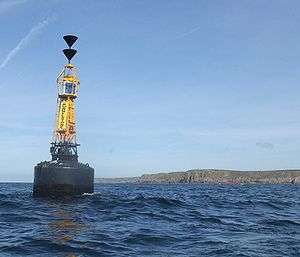Runnel Stone
Coordinates: 50°01′48″N 5°40′30″W / 50.030°N 5.675°W

The Runnel Stone (Cornish: Men Reunel, meaning stone abounding in seals), or Rundle Stone, is a hazardous rock pinnacle situated about 1-mile (1.6 km) south of Gwennap Head, Cornwall, England, United Kingdom that used to show above the surface at low water until a steamship struck it in 1923.
Marks
A buoy currently marks the position of the Runnel Stone. Until May 2012 it was topped with a flashing light, a bell which peals with the movement of the waves and was also fitted with a whistle set in a tube, which emitted a moaning sound when there was a good swell running. This mournful noise could be heard clearly from Gwennap Head, drifting in from the sea, and added to the eerie atmosphere on the cliffs in foggy conditions. In a gale during the 1960s, the buoy became tangled in a drifting cargo ship's anchor line, and the buoy was towed into Mount's Bay.[1] On 13 May 2012, the buoy was replaced by THV Patricia with a larger one, with a whistle to replace the bell.[2][3]
One 19th century attempt to attach a warning buoy to the Runnel Stone was led by the naval Lieutenant Hugh Goldsmith (nephew of the famous poet Oliver Goldsmith) aboard the cutter HMS Nimble. After several unsuccessful attempts Lt Goldsmith and a number of his crew turned their attention inland and succeeded in toppling the famous rocking stone, Logan Rock from its precarious perch on the Treryn Dinas headland east of Porthcurno, much to the dismay of local people.
Day markers on Tol-pedn

There are a pair of cone-shaped navigation markers on Gwennap Head, in line with the Runnel Stone buoy. These are day markers warning vessels of the hazard of the Runnel Stone. The cone to the seaward side is painted red and the inland one is black and white. When at sea the black and white one should always be kept in sight in order to avoid the submerged rocks nearer the shore. If the black and white cone is completely obscured by the red cone then the vessel would be directly on top of the Runnel Stone. The landmark was erected by the Corporation of Trinity House in 1821 – an event recorded on a plaque on the back of the black and white marker.[1]
Shipwrecks
Between 1880 and 1923 over thirty identified steamships were wrecked, stranded or sank in the area.[4]
On a calm mid-summer day during World War I, a Royal Navy minesweeper hit the rock despite a local fisherman serving on board as a rating. He was aware that the ship was on a collision course, but was advised to keep quiet by a colleague in case he might be disciplined for criticising his superiors![1]
On a foggy day at 3pm, 8 October 1923, the 6,000 ton SS City of Westminster bound from Belfast to Rotterdam with a cargo of South African maize knocked the top of the reef clean off. A total of seventy-two people were taken off by the Sennen and Penlee lifeboats.[4] Today, the remains of the ship lie in 30 metres (98 ft) of water, jammed into a gully on the eastern side of the stone. The rock is now less dangerous and there have been no wrecks since.[1]
Diving
Due to its exposure to the ocean currents and its relative accessibility of slipways at Porthgwarra and Lamorna, the Runnel Stone is known as one of the best dive sites in the whole of Cornwall.[5] Diving must be carried out at slack water, which is about one and a half hours before high water at Newlyn. The highlights include visibility of up to 20m, numerous wrecks, and anemones in a vast array of colours.
Marine Conservation Zone
The Runnel Stone Marine Conservation Zone (also known as Land's End (Runnel Stone)) was designated on 29 January 2016 and covers 20 km².[6] The Conservation Zone boundary is a 3.5 km arc based on and to the south of the National Coastwatch Institution lookout on Gwennap Head. Included is the coast from Gwennap Head to Hall Dinas on the east side of Treryn Dinas. As well as protecting deep sea rocks on the Runnel Stone reef, the MCZ also protects other habitats ranging from exposed rock on the coast to soft sediments on the sea floor. Animals within the zone include sea anemones, sea fans and sponges.[7]
Literature
The Cones of Runnel are used as a clue in the 1940 World War II thriller The Trojan Horse by Hammond Innes.
References
- 1 2 3 4 Gendall, Christine (1999). Porthgwarra. St Buryan: Churchtown Technology. p. 60.
- ↑ "Notice To Mariners". Trinity House. Retrieved 18 May 2012.
- ↑ Williamson, Laurie (17 March 2012). "Coastwatch". The Cornishman.
- 1 2 Larn, Richard (1996). Dive South Cornwall. Underwater World Publications. p. 211. ISBN 0-946020-25-6.
- ↑ Hood, Charles (2003). 100 Best Dives in Cornwall. Circle Books. p. 87. ISBN 0-9538919-3-3.
- ↑ "The Runnel Stone Marine Conservation Zone Designation Order 2016". Legislation.gov.uk. GOV.UK. Retrieved 24 January 2016.
- ↑ "Runnel Stone Marine Conservation Zone". GOVUK. Retrieved 24 January 2016.
- Some of the above information is extracted from material on display in the visitors' room at the Coastwatch station on Gwennap Head near Porthgwarra.